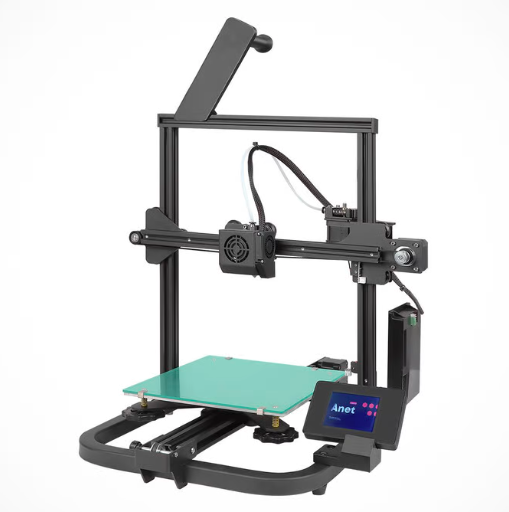Compare K1 Max vs A8 V2
Comparison between the best 3D printers
Choose the best 3D printer at the best price. The cheapest 3D printers are here.
Buy a 3D printer here with 3D Fila.
 |
 |
|
| Model | K1 Max[BUY K1 Max] |
A8 V2 |
| Printing Material | Filament | Filament |
| Buy Filament for Creality 3D K1 Max | Buy Filament forAnet A8 V2 | |
| Estimated price | $1300,00 | $129,00 |
| Manufacturer | Creality 3D | Anet |
| Release Year | 2023 | 2021 |
| Print Volume [mm] | 300x300x300 | 220x220x250 |
| Printer Size [mm] | 435x462x526 | 428x441x486 |
| Weight [kg] | 18 | 6,2 |
| Power Loss Recovery | YES | NO |
| Enclosed printer | YES | NO |
| Bed Leveling | Automatic | Manual |
| Filament End Sensor | YES | NO |
| Bed type | Heated | |
| Power supply system | Direct Drive | Bowden |
| Standard nozzle | 0,4 | 0,4 |
| Maximum Nozzle Temperature [°C] | 300 | 230 |
| Maximum Bed Temperature [°C] | 100 | |
| Maximum printing speed [mm/s] | 600 | 150 |
| Filament holder | YES | YES |
| Camera for supervision | YES | YES |
| Recommended filaments | ABS, PLA, PETG, TPU, PA, ASA, PC, PLA-CF, PA-CF, PET-CF | PLA |
| Recommended slicers | Creality Print, Cura, Simplify, Slic3r, IdeaMaker e outros | Cura, Simplify, Slic3r, IdeaMaker |
| Maximum Resolution [mm] | 0,1 | 0,1 |
| Processor | ||
| Display | Display touchscreen 4,3'' | Display touchscreen 2,8'' |
| Power Supply | 110/220V / 250W | |
| Connectivity | USB / Wi-Fi / Ethernet | SD / USB |
| Operating systems | Windows, Mac, Linux | Windows, Mac, Linux |
| Date of registration in the system | 2023-12-01 | 2022-11-10 |
| Release date | 2023 | 2021 |
| Extra features | The Creality K1 Max stands out as a fast Core XY 3D printer with a large build volume of 300 x 300 x 300 mm. It is fully enclosed and equipped with AI sensors to prevent print failures. This model has a smooth and flexible PEI build platform, and uses an automatic leveling system with LIDAR, as well as a filament run-out sensor. LAN, Creality Cloud and USB Flash Disk connectivity are available, as well as a 4.3-inch touchscreen interface. The K1 Max is robust, weighing in at 18 kg, and includes an AI camera and limited version of the Klipper firmware. Its motion system is solid and the printer is efficient with high-temperature filaments, but it is not silent. Assembly is 99% complete, requiring only minor adjustments before use. | The Anet A8 V2 is a Cartesian-XZ type 3D printer with a build volume of 220 x 220 x 250 mm, Ender 3 design and V-slot assembly. It has a 32-bit motherboard and touchscreen interface, promising ease of use. It uses open source firmware and has thermal failure protection. It stands out for its cable organization and the absence of a heated bed, focusing on energy savings and PLA printing. It comes with an external power adapter, aiming at greater safety, especially for beginners and educational use. |
| Support for multiple colors and materials (AMS and CFS) | NO | NO |
Notes * |
||
| Cost-benefit | 7 / 10 | 6 / 10 |
| Hardware | 4.8 / 10 | 0.6 / 10 |
| Tela | . | . |
| Print volume | 4 / 10 | 3 / 10 |
| Performance | 5 / 10 | 1 / 10 |
| [BUY K1 Max] |
Conclusion |
| When comparing the Creality K1 Max and the Anet A8 V2, it’s clear that both 3D printers cater to distinct user needs and preferences, making them compelling options in their respective categories. The K1 Max impresses with its advanced features and larger print volume, making it particularly suitable for serious hobbyists and professionals who require a printer that can handle a wide range of materials and high-speed printing. Its enclosed design, automatic bed leveling, and power loss recovery capabilities are significant advantages, enhancing usability and mitigating common printing issues. Additionally, its extensive connectivity options and robust construction point to a long-lasting investment, despite its higher price. On the other hand, the Anet A8 V2 stands out for beginners or those looking for a more budget-friendly option. While its specifications are more modest—offering a smaller print volume and simpler features—it is an accessible choice for those who prioritize ease of use and entry into 3D printing. The focus on PLA printing and energy savings aligns well with educational purposes or light hobbyist work. In summary, while the K1 Max is a powerful, feature-rich machine ideal for advanced use, the A8 V2 serves as an economical introduction to 3D printing. The decision ultimately hinges on the buyer's printing needs, experience level, and budget, making both models worthwhile contenders in their respective segments. |

